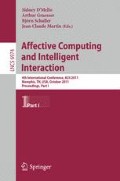Abstract
This paper discusses the power of emotions in our health, happiness and wholeness, and the emotional impact of movies. It presents iFelt, an interactive video application to classify, access, explore and visualize movies based on their emotional properties and impact.
Access this chapter
Tax calculation will be finalised at checkout
Purchases are for personal use only
Preview
Unable to display preview. Download preview PDF.
References
Ahlberg, C., Truvé, S.: Tight coupling: Guiding user actions in a direct manipulation retrieval system. In: People and Computers: Proc. of HCI 1995, pp. 305–321 (1995)
Arijon, D.: Grammar of the film language. Focal Press (1976)
Baird, J., Nadel, L., Lipton, B.: Happiness Genes: Unlock the Positive Potential Hidden in Your DNA. New Page Books (2010)
Banerjee, S., Greene, K., Krcmar, M., Bagdasarov, Z., Ruginyte, D.: The role of gender and sensation seeking in film choice: Exploring mood and arousal. Journal of Media Psychology: Theories, Methods, and Applications 20(3), 97–105 (2008)
Bardzell, S., Bardzell, J., Pace, T.: Understanding Affective Interaction: Emotion, Engagement, and Internet Videos. In: Proc. of IEEE ACII, Amst., NL (September 10-12, 2009)
Damasio, A.: Descartes’ Error. Harper Perennial (1995)
Ekman, P.: Are there basic emotions? Psychological Review 99(3), 550–553 (1992)
Gross, J., Levenson, R.: Emotion Elicitation Using Films. Cognition & Emotion 1(9) (1995)
Hanjalic, A., Xu, L.-Q.: Affective video content representation and modeling. IEEE Transactions on Multimedia 7(1) (2005)
Hicks, E., Hicks, J.: The Astonishing Power of Emotions: Let Your Feelings Be Your Guide. Hay House (2007)
Huppert, F.: Positive emotions and cognition: developmental, neuroscience and health perspectives. In: Forgas, J.P. (ed.) Hearts and Minds: Affective Influences on Social Cognition and Behavior, Psychology Press, New York (2006)
Isen, A.M., Daubman, K.A., Nowicki, G.P.: Positive affect facilitates creative problem solving. Journal of Personality and Social Psychology 52, 1122–1131 (1987)
James, W.: What is an Emotion? Mind 9(34), 188–205 (1884)
Kreibig, S., Wilhelm, F., Roth, W., Gross, J.: Cardiovascular, electrodermal, and respiratory response patterns to fear- and sadness-inducing films. Psychophysiology 44(5), 787–806 (2007)
Langlois, T., Chambel, T., Oliveira, E., Carvalho, P., Marques, G., Falcão, A.: VIRUS: Video Information Retrieval Using Subtitles. In: Proc.of Academic MindTrek 2010 (2010)
Martinho, J., Chambel, T.: ColorsInMotion: Interactive Visualization and Exploration of Video Spaces. In: Proc. of Academic MindTrek 2009, Tampere, Finland (September-October 2009)
Mauss, I., Robinson, M.: Measures of emotion: A review. Cognition & Emotion 23(2), 209–237 (2009)
Money, A., Agius, H.: Analysing user physiological responses for affective video summarization. Displays 30(2), 59–70 (2009)
Münsterberg, H.: The film: A psychological study: The silent photoplay in 1916. Dover Public, New York (1970)
Oliveira, E., Martins, P., Chambel, T.: iFelt: Accessing Movies Through Our Emotions. In: Proceedings of EuroiTV 2011, Lisbon, Portugal (June 29-July 1, 2011)
Oliveira, E., Benovoy, M., Ribeiro, N., Chambel, T.: Towards Emotional Interaction: Using Movies to Automatically Learn Users’ Emotional States. In: Campos, P., Graham, N., Jorge, J., Nunes, N., Palanque, P., Winckler, M. (eds.) INTERACT 2011, Part I. LNCS, vol. 6946, pp. 152–161. Springer, Heidelberg (2011)
Philippot, P., Baeyens, C., Douilliez, C., Francart, B.: Cognitive regulation of emotion: Application to clinical disorders. In: Philippot, P., Feldman, R.S. (eds.) The Regulation of Emotion. Laurence Erlbaum Associates, New York (2004)
Picard, R., Vyzas, E., Healey, J. Toward Machine Emotional Intelligence: Analysis of Affective Physiological State. IEEE Trans. on Pattern Analysis & Machine Intel. (2001)
Plutchik, R.: Emotion: A psychoevolutionary synthesis. Harper & Row, New York (1980)
Rocha, T., Chambel, T.: VideoSpace: a 3D Video Experience. In: Proceedings of Artech 2008, 4th International Conference on Digital Arts, Porto, Portugal (November 2008)
Russell, J.: A circumflex model of affect. Journal of Personality and Social Psychology 39, 1161–1178 (1980)
Scherer, K.: What are emotions? and how can they be measured? Social Science Information 44(4), 695 (2005)
Seligman, M., Csikszentmihalyi, M.: Positive Psychology: An Introduction. American Psychologist 55(1), 5–14 (2000)
Seligman, M.: Martin Seligman on positive psychology, TED Talk (February 2004)
Soleymani, M., Chanel, C., Kierkels, J., Pun, T.: Affective Characterization of Movie Scenes Based on Content Analysis and Physiological Changes. In: Int. Symp. on MM (2008)
Tan, E.S.: Film-induced affect as a witness emotion. Poetics In Emotions and Cultural Products 23(1-2), 7–32 (1995)
Westermann, R., Spies, K., Stahl, G., Hesse, F.W.: Relative effectiveness and validity of mood induction procedures: a meta-analysis. Eur. Journal of Social Psychology 26(4), 557–580 (1996)
Author information
Authors and Affiliations
Editor information
Editors and Affiliations
Rights and permissions
Copyright information
© 2011 Springer-Verlag Berlin Heidelberg
About this paper
Cite this paper
Chambel, T., Oliveira, E., Martins, P. (2011). Being Happy, Healthy and Whole Watching Movies That Affect Our Emotions. In: D’Mello, S., Graesser, A., Schuller, B., Martin, JC. (eds) Affective Computing and Intelligent Interaction. ACII 2011. Lecture Notes in Computer Science, vol 6974. Springer, Berlin, Heidelberg. https://doi.org/10.1007/978-3-642-24600-5_7
Download citation
DOI: https://doi.org/10.1007/978-3-642-24600-5_7
Publisher Name: Springer, Berlin, Heidelberg
Print ISBN: 978-3-642-24599-2
Online ISBN: 978-3-642-24600-5
eBook Packages: Computer ScienceComputer Science (R0)

